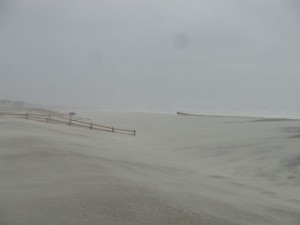A northeast gale continues to blow, but a tour on Sunday morning at low tide reveals the substantial erosion that already has occurred across the length of Ocean City's beaches.
The relentless northeast swell continues to carve into the dunes between Fourth and Sixth streets in Ocean City, NJ.
See slide show above for images from different parts of the island.
Ocean City has been wedged between two weather systems spinning in opposite directions, and the resulting powerful northeast winds have lasted for about two weeks and intensified over the past four days.
The gale has generated stormy surf that has pushed water into the back bays and caused street flooding and the highest tides of the past two years. (Read more:
Northeast Gale Continues to Flood Ocean City)
But the greatest impact on Ocean City has been on the beaches and dunes, which have lost a lot of sand to the pounding surf.
With the waves and tides still high, it's hard to tell exactly what the impact of the storm will be. But one measure might be an old wooden groin that was slightly exposed just three weeks ago. On Sunday morning, it appeared that the beach had lost more than a foot of elevation — with that much more of the groin showing.
[gallery columns="2" ids="29469,29470"]
A handheld GPS showed a journey of 281 yards from the bulkhead to the water's edge at 58th Street a little more than a week ago. The same trip on Sunday at low tide measured just 211 yards.
Because tides and waves are so fluid, it's hard to make comparisons from day to day. And beaches eroded by storms often regenerate — with sand that had been pulled into the surf zone pushed back onto the beaches over time. But when the storm subsides, it seems almost certain that Ocean City's beaches will be much lesser.
The Army Corps of Engineers had just completed the Ocean City portion (between 37th and 59th streets) of a $57 million project to rebuild beaches and dunes on Tuesday (Sept. 29) during a brief lull in the northeast gale. Less than a week later, much of the sand is gone.

The beach at 57th Street on Sunday, Oct. 4.
But the rebuilt beaches achieved their purpose: to protect property at a place where the ocean met the bay during Superstorm Sandy. At low tide on Sunday morning, the beaches still appeared high and wide (211 yards at 58th Street), and the ocean waves had not diminished the new dune line that runs the length of the project area.
The powerful winds, however, seemed to be scouring sand from the top of the dunes, which have not yet been planted with dune grass.
At the northern end of the island — where a beach replenishment project is scheduled to begin later this month between Seaspray Road and 15th street — the waves are carving into protective dunes at several different beaches. News sections of jetty, outfall pipes and wooden groins are exposed on the eroded beaches.
The widest and healthiest beaches between 20th and 50th streets appear to be weathering the gale well.
 The beach at 57th Street on Sunday, Oct. 4.
But the rebuilt beaches achieved their purpose: to protect property at a place where the ocean met the bay during Superstorm Sandy. At low tide on Sunday morning, the beaches still appeared high and wide (211 yards at 58th Street), and the ocean waves had not diminished the new dune line that runs the length of the project area.
The powerful winds, however, seemed to be scouring sand from the top of the dunes, which have not yet been planted with dune grass.
At the northern end of the island — where a beach replenishment project is scheduled to begin later this month between Seaspray Road and 15th street — the waves are carving into protective dunes at several different beaches. News sections of jetty, outfall pipes and wooden groins are exposed on the eroded beaches.
The widest and healthiest beaches between 20th and 50th streets appear to be weathering the gale well.
The beach at 57th Street on Sunday, Oct. 4.
But the rebuilt beaches achieved their purpose: to protect property at a place where the ocean met the bay during Superstorm Sandy. At low tide on Sunday morning, the beaches still appeared high and wide (211 yards at 58th Street), and the ocean waves had not diminished the new dune line that runs the length of the project area.
The powerful winds, however, seemed to be scouring sand from the top of the dunes, which have not yet been planted with dune grass.
At the northern end of the island — where a beach replenishment project is scheduled to begin later this month between Seaspray Road and 15th street — the waves are carving into protective dunes at several different beaches. News sections of jetty, outfall pipes and wooden groins are exposed on the eroded beaches.
The widest and healthiest beaches between 20th and 50th streets appear to be weathering the gale well.